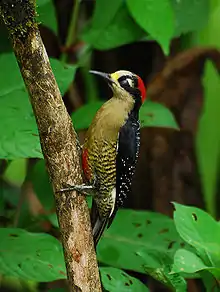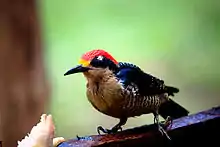Black-cheeked woodpecker
The black-cheeked woodpecker (Melanerpes pucherani) is a resident breeding bird from southeastern Mexico south to western Ecuador.
| Black-cheeked woodpecker | |
|---|---|
 | |
| Female in Costa Rica | |
 | |
| Male in Costa Rica | |
| Scientific classification | |
| Kingdom: | Animalia |
| Phylum: | Chordata |
| Class: | Aves |
| Order: | Piciformes |
| Family: | Picidae |
| Genus: | Melanerpes |
| Species: | M. pucherani |
| Binomial name | |
| Melanerpes pucherani (Malherbe, 1849) | |
 | |
This woodpecker occurs in the higher levels of wet forests, semi-open woodland and old second growth. It nests in an unlined hole 6–30 m (20–98 ft) high in a dead tree. The clutch is two to four glossy white eggs, incubated by both sexes.
The binomial commemorates the French zoologist Jacques Pucheran.[2]
The black-cheeked woodpecker feeds on insects, but will take substantial quantities of fruit and nectar.[3]
This common and conspicuous species gives a rattling krrrrrl call and both sexes drum on territory.
Description
The adult is 18.5 cm (7.3 in) long and weighs 63 g (2.2 oz). It has black upperparts with white barring on the back, white spotting on the wings and a white rump. The tail is black with some white barring, and the underparts are pale buff-olive with a red central belly. There is a black patch through the eyes and on the cheeks, a yellow forehead, and a red nape. The crown is red in the male and black in the female. Young birds are duller, have less white above and less red on the belly.[3]
References
- BirdLife International (2012). "Melanerpes pucherani". IUCN Red List of Threatened Species. 2012. Retrieved 26 November 2013.CS1 maint: ref=harv (link)
- Jobling, James A. (2010). The Helm Dictionary of Scientific Bird Names. London: Christopher Helm. p. 323. ISBN 978-1-4081-2501-4.
- Stiles, F. Gary; Skutch, Alexander F. (1989). A Guide to the Birds of Costa Rica. Ithaca, NY: Cornell University. pp. 252–253. ISBN 978-0-8014-9600-4.
Further reading
- Skutch, Alexander F. (1969). "Blue-cheeked woodpecker" (PDF). Life Histories of Central American Birds III: Families Cotingidae, Pipridae, Formicariidae, Furnariidae, Dendrocolaptidae, and Picidae. Pacific Coast Avifauna, Number 35. Berkeley, California: Cooper Ornithological Society. pp. 518–521.
